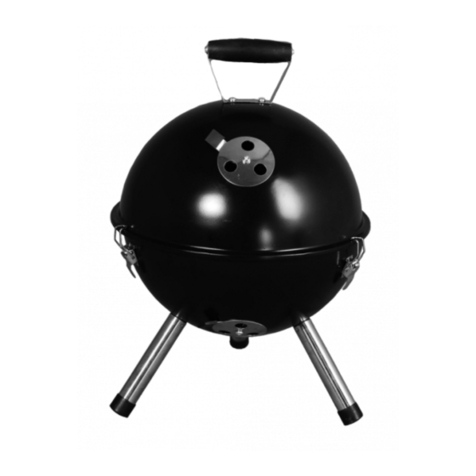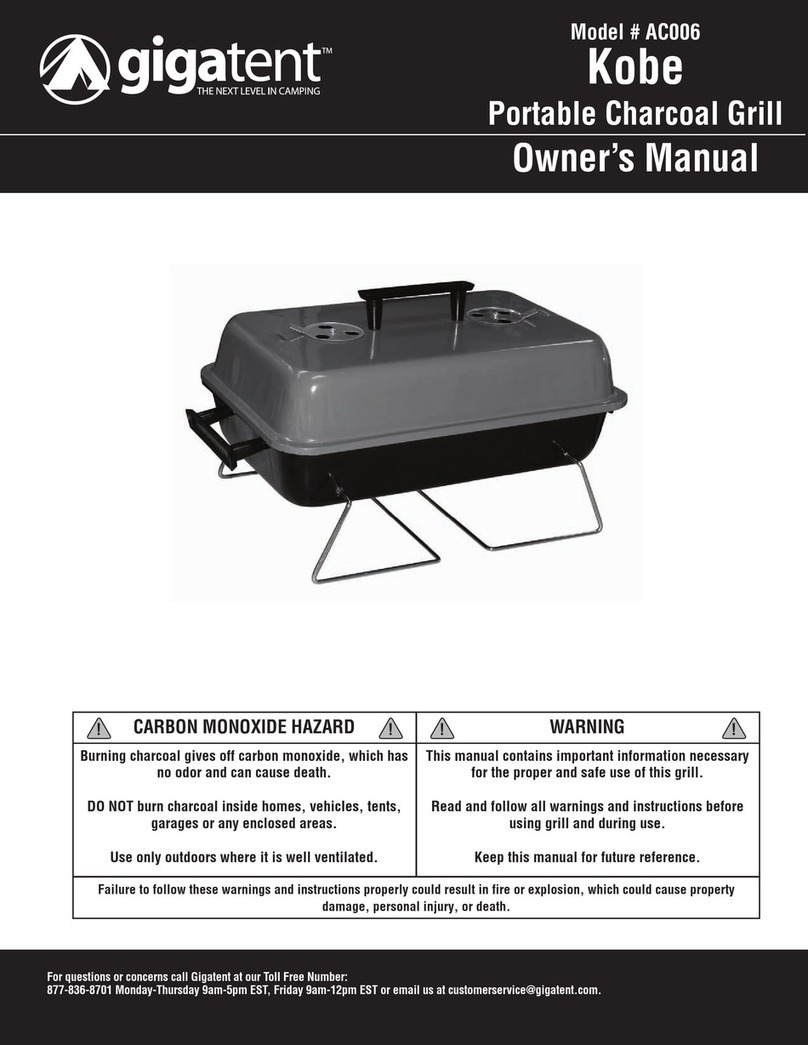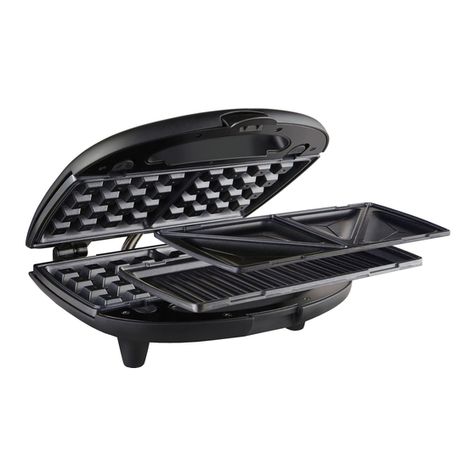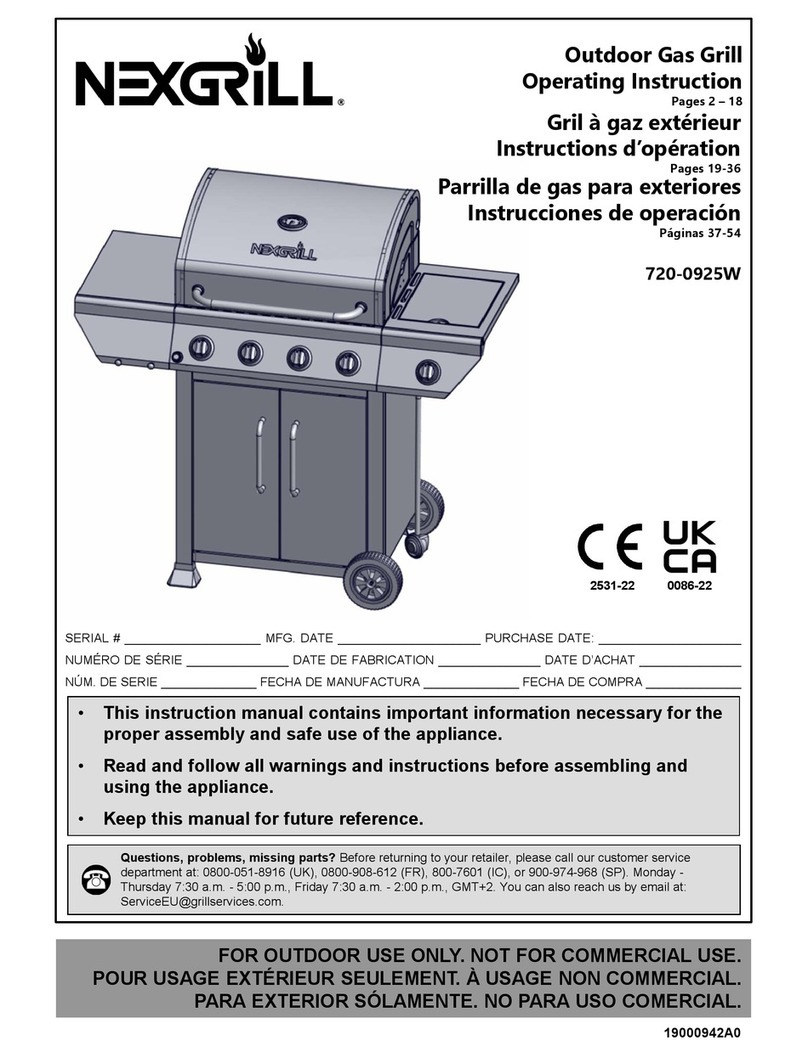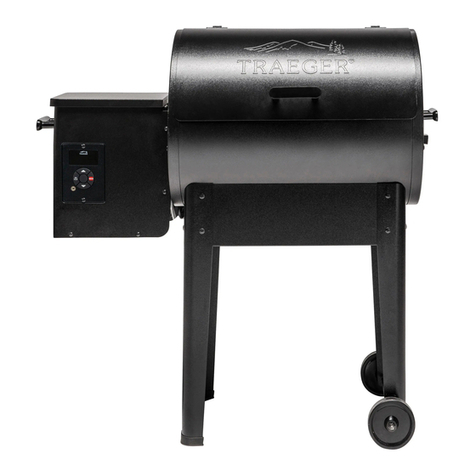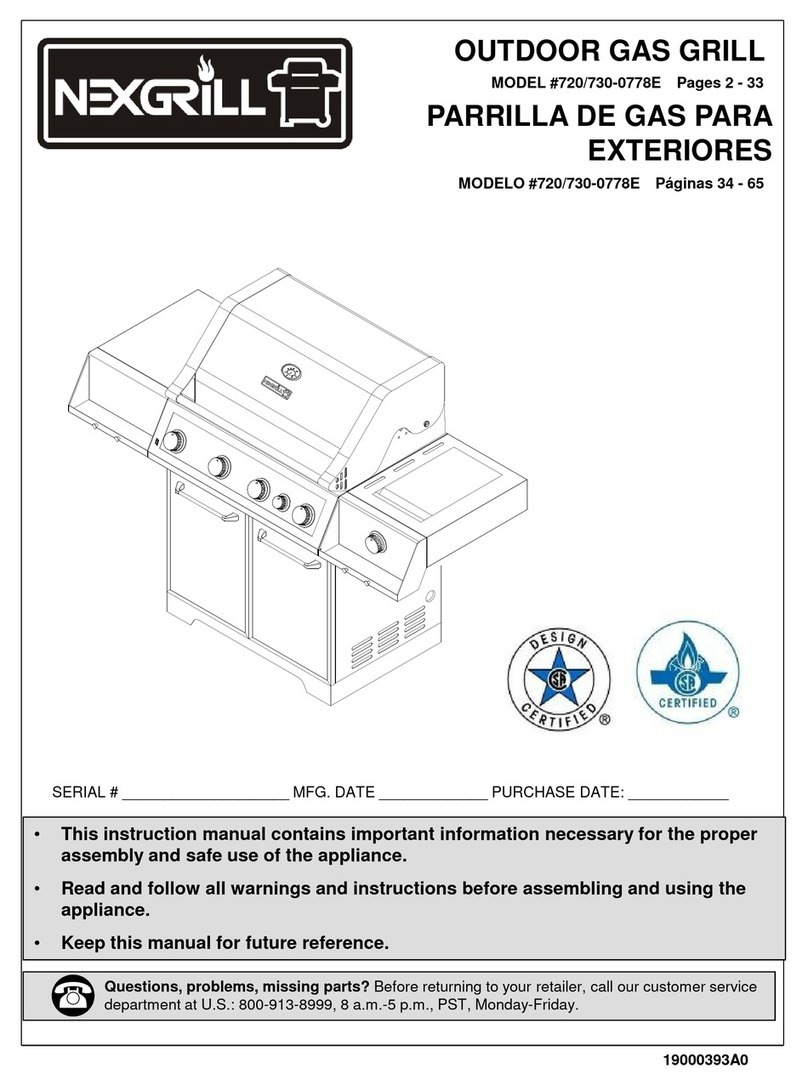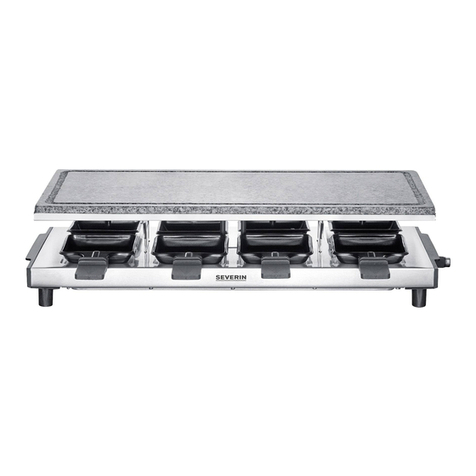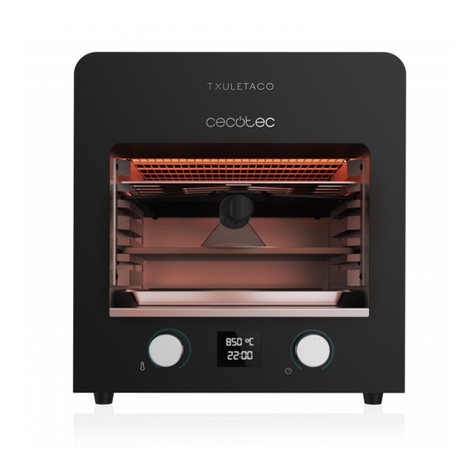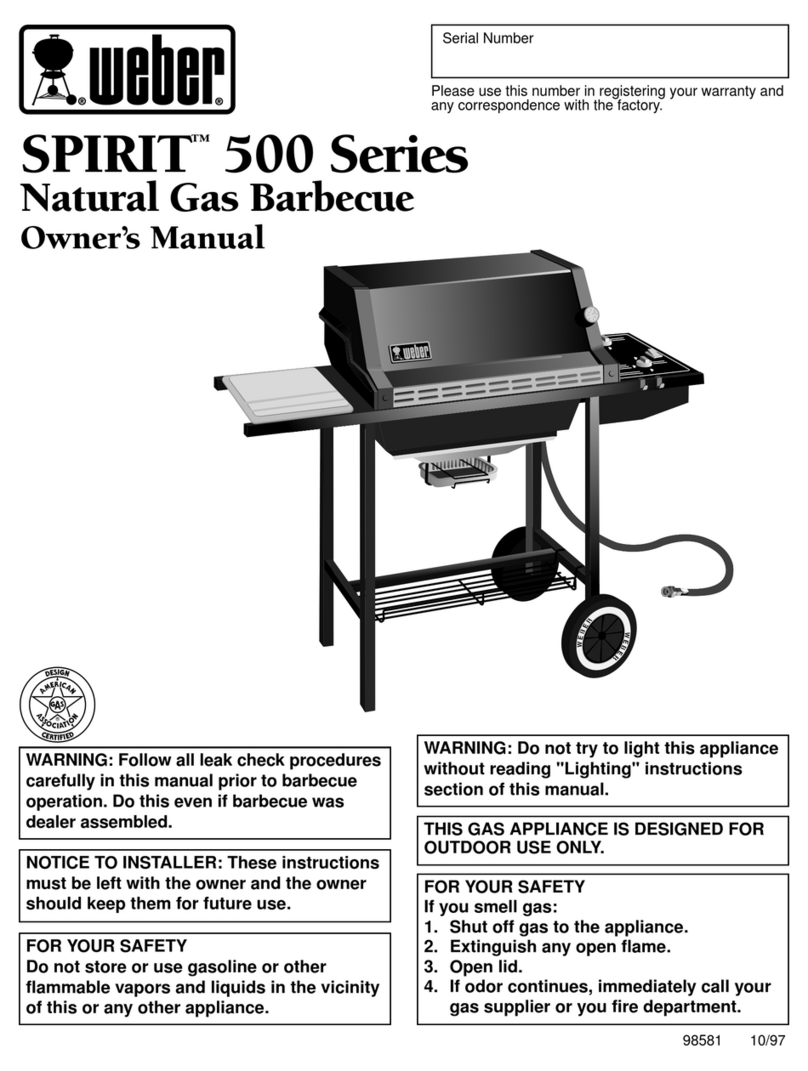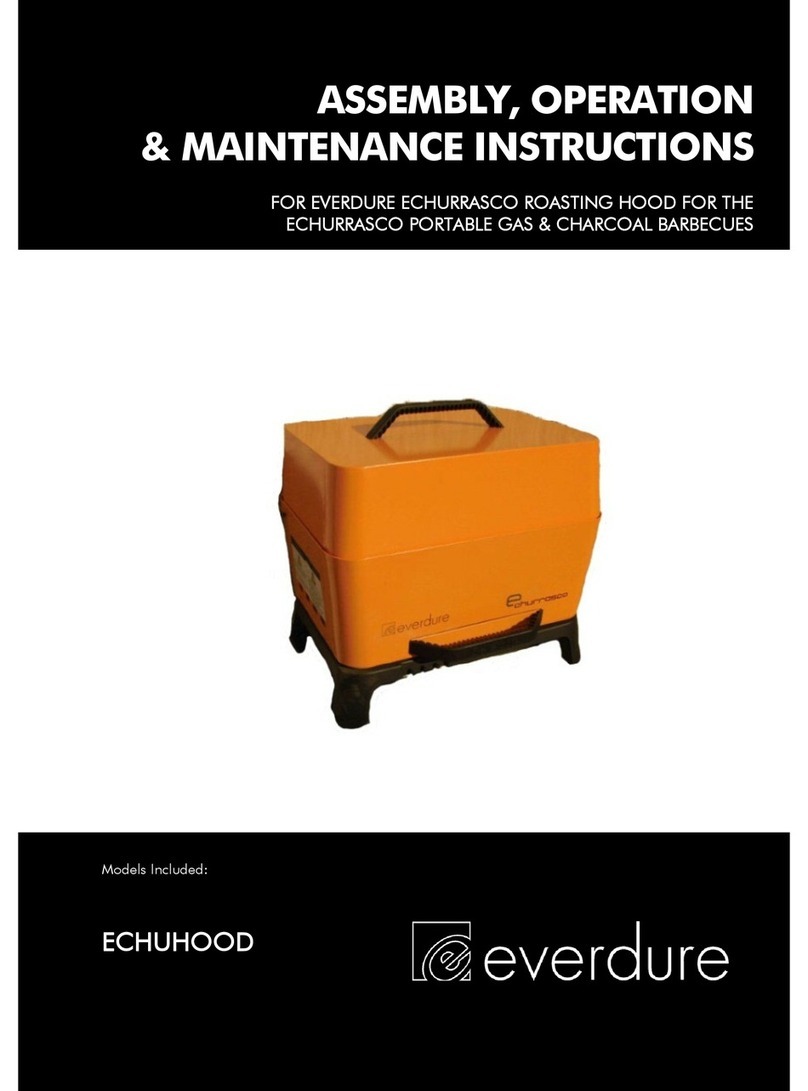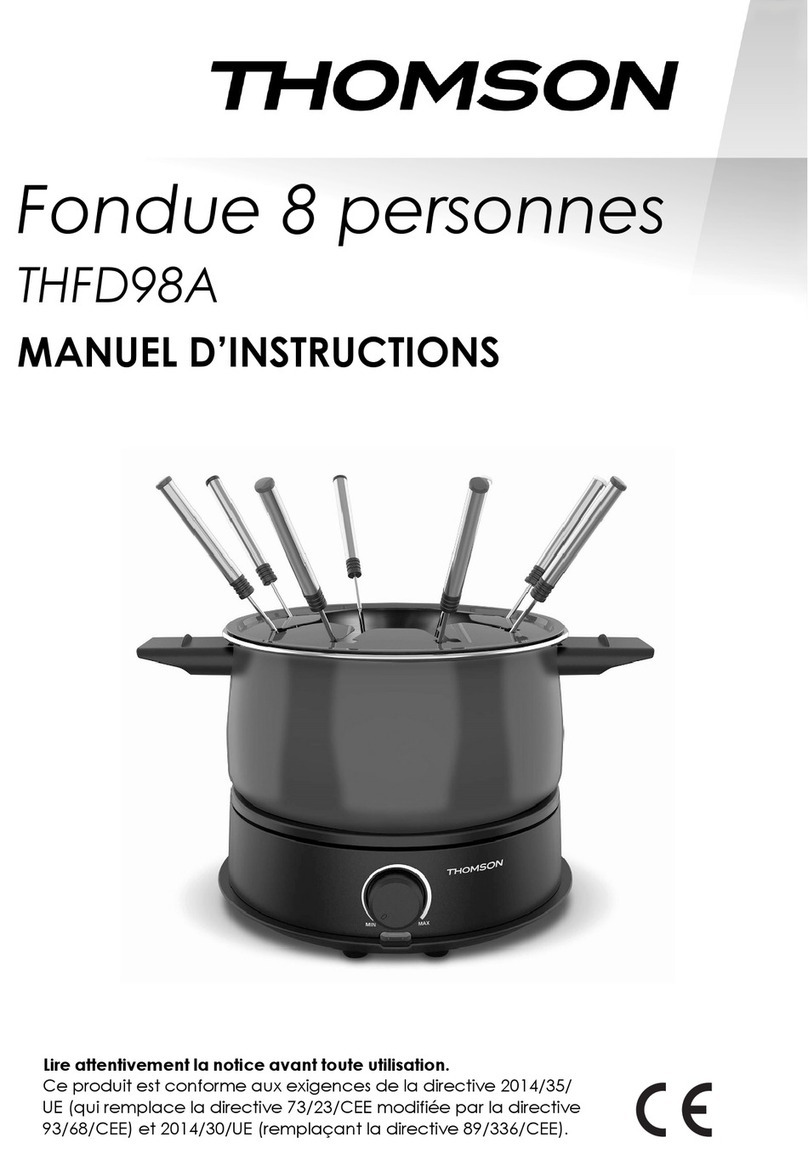GRILLMAN 200YG User manual

Model 200YG Model 300YG
Model 400YG Model 600PC
Consumer/User: Read all of these instructions, and keep
them in a safe place for future reference.
The
Grill
Owner’s Manual

II
DANGER
If you smell gas:
1. Shut off gas to the appliance
2. Extinguish any open flame
3. Open lid
4. If odor continues, eep away from the appliance and imme-
diately call your gas supplier or fire department.
WARNING
1. Do not store or use gasoline or other flammable liquids or
vapors in the vicinity of this or any other appliance.
2. An LP cylinder not connected for use shall not be stored in
the vicinity of this or any other appliance.
ANSI/CGA Standard
Designaon
18 S
ANSI Z21.58b CGA 1.6b -2005 OU DOOR COOKING APPLIANCE

Table of Contents
Choosing a Safe Location for a Gas Barbecue Grill ................2
Portable L.P. Gas Barbecue Grills ..........................................3
Take These Instructions to the L.P. Gas Dealer .................... 6
Installing a L.P. Gas Cylinder ..................................................8
Leak Testing ...........................................................................10
Lighting Instructions ................................................................11
Burner's Flame ....................................................................... 13
Caring for Your Gas Grill .........................................................14
Clearing the Burner Tube ........................................................15
Storing a L.P. Gas Barbecue Grill ...........................................16
Replacement Parts & Contact Information ..............................17

2
Choosing a Safe Location for a Gas Barbecue
1. The gas barbecue grill may only be used for cooking out-of-doors.
•
Do not operate this barbecue in garages, breezeways, sheds or any enclosed area.
•
Operating this or any gas-fired appliance in an enclosed area can produce a build-up of carbon-monoxide, which
could result in in ury or death.
2. Installation must conform with local codes or, in the absence of local codes, with either the National Fuel *Gas Code,
ANSI Z223.1, NFPA 54,Natural Gas and Propane Installation Code, CSA B149.1, or Propane Storage and Handling Code,
B149.2, or the Standard for Recreational Vehicles , ANSI A 119.2/NFPA 1192, and CSA Z240 RV Series, Recreational
Vehicle Code, as applicable.
To check local codes, contact your local gas dealer or gas company listed in the Yellow Pages for recommended installa-
tion procedures and regulations.
3. This appliance is not intended to be installed in or on a recreational vehicle and/or boat.
4 . Keep the barbecue grill at least 36 inches (92 cm) away from any combustible construction.
•
Do not use a grill under a ceiling or cover where the heat or flame could cause damage.
•
Choose a level surface where the grill is not facing directly into the wind.
•
Avoid moving the grill during use.
5. The grill area must be clear and free from combustible materials, gasoline, and any other flammable liquids or vapors.
•
Do not use lighter fluid or charcoal briquettes in a gas grill. The flow of combustion and ventilation air is not to be
obstructed. The ventilation openings of the cylinder enclosure must be kept free and clear from other debris.
6. NOT FOR USE BY CHILDREN.
Keep children and pets away from hot grill!
•
Place your barbecue grill in a location away from children and pets.
•
Do not leave grill unattended when in use.
7. The outside of the barbecue grill will become hot during use.
•
To avoid burns, do not touch any hot grill surface. If necessary, use a protective glove when operating control knobs,
tank shut-off valve, or lid handle.
•
Do not place combustible material, such as cloth or plastic, on grill surface during use.
•
Do not lean on side tables or place more than 25 pounds of weight on a side table.

3
Portable Liquid Propane Gas Barbecue Grills
WARNING: Do not use natural gas in an appliance designed for L.P. gas. Use only
liquid propane (L.P.) gas in an appliance designed for L.P. gas.
L.P. Gas
Liquid Propane (abbreviated L.P.) gas is stored under high pressure inside a
cylinder and vaporizes when released. It is important that there are no leaky connections
on the grill*s fuel supply system.
The L.P. FUEL SUPPLY SYSTEM
A L.P. gas grill requires a fuel delivery system made up of a L.P. gas supply
cylinder, a fuel regulator with hose and a gas-control valve.
Valve Orifice
Burner fuel-control valve
Fuel regulator
Fuel supply hose ype 1 coupler
Cylinder control valve
LP Gas cylinder

4
FUEL REGULATOR AND HOSE
The fuel regulator supplied is equipped with a Type 1 coupling nut. Do not at-
tempt to connect to any other L.P. cylinder not equipped with a mating Type 1 cylinder
valve. This grill is not to be used with any other cylinder connection device.
The fuel regulator and hose assembly with the Type 1 fitting supplied must be
used with the appliance. Do not use a hose and regulator assembly other than the one
supplied with the grill or a manufacturer’s replacement fuel pressure regulator assembly.
The Type 1 connection system has the following features:
1. The system will not allow gas to flow until a positive connection has been made.
2. The system has a thermal element that will shut off the flow of gas between 240*F
and 300*F.
3. The system has a flow-limiting device which when activated will limit the flow of gas to
10 cubic feet per hour.
4. The pressure regulator and hose assembly provided is factory set at an outlet pres-
sure of 11 inches water column (.4 lb. per sq. inch).
*WARNING: Any attempt to adjust the regulator is dangerous and could create a situa-
tion causing personal injury or property damage. Consult your L.P. gas dealer if you think
the regulator is not working properly.
FUEL-CYLINDER SPECIFICATIONS
Any L.P. gas-supply cylinder used with this grill must be approximately 12 inch-
es in diameter and 18 inches high. The maximum fuel capacity must be 20 pounds of
propane. Full-cylinder weight should be approximately 38 pounds (43.7 lbs. nominal wa-
ter capacity).
The L.P. cylinder must have a shut-off valve terminating in a Type 1 L.P. gas-
cylinder-valve outlet. A Type 1 compatible cylinder with a Type 1 cylinder valve has a
positive seating connection that does not permit gas flow until a positive seal has been
obtained.
Portable L. P. Gas Barbecue Grills

5
Portable L.P. Gas Barbecue Grills
DANGER: Do not insert any foreign objects into the valve outlet. You may damage
the back check. A damaged back check can cause a leak, which could result in explosion,
fire, severe personal injury, or death.
The cylinder must be arranged for vapor withdrawal. It must also include a collar to pro-
tect the cylinder valve. A safety-relief device having direct communication with the vapor space of
cylinder must be provided. This will expel high-pressure gas if the cylinder is overfilled or overheat-
ed.
All L.P. gas cylinders used with this appliance shall be constructed and marked in accord-
ance with the specifications for L.P. gas cylinders of the U.S. Department of Transportation (DOT)
or the National Standard of Canada, CAN/CSAB339, Cylinders, Spheres and Tubes for Transporta-
tion of Dangerous Goods; and Commission, as applicable; and shall be provided with a listed over-
filling-prevention device. Read labels on the L.P. gas-supply cylinder.
If a cylinder is provided by Grillman Grills, it is empty for safety. Allow only a qualified L.P.
gas dealer to fill or repair your L.P. gas-supply cylinder.
Inform the gas dealer if it is a new or used cylinder to be filled. Caution the gas dealer not
to overfill the fuel cylinder.
After filling, have the gas dealer check for leaks and to check that the relief valve remains
free to function.
Have the gas dealer weigh cylinder after filling to ensure that the cylinder is not overfilled.
DANGER:
Never fill the gas cylinder beyond 80 percent full.
If this information is not followed exactly, a fire, causing death or serious injury, may occur.
TRANSPORTING A FULL CYLINDER
WARNING! Handle a full cylinder with care. Gas is under high pressure.
Transport the cylinder in an upright and secure manner with control valve turned off and
the POL plug in place.
Do not transport cylinder in the passenger compartment of a vehicle.
Do not leave cylinder in direct sunlight or in a high-heat area such as a closed car trunk.
High-heat areas could cause the relief valve to vent gas.
Do not store cylinder in a building, garage or any other enclosed area. Store outdoors in a
well ventilated area, away from people and out of the reach of children.
Use a cylinder cap on cylinder-valve outlet during transport and when the cylinder is not
connected to grill. Keep cylinder valve closed when not in use.

6
Ta e These Instructions to the L.P. Gas Dealer
When using a cylinder exchange, be sure the exchanged cylinder is a
Type 1 cylinder; a 51 POL cylinder will not fit a Type 1 regulator.
FILLING AND PURGING TYPE 1 L.P. GAS CYLINDERS
DANGER! Purging and filling of L.P. Gas cylinders must be per-
formed by personnel who have been thoroughly trained in accepted L.P.
gas industry procedures. Failure to follow this instruction may result in
explosion, fire, severe personal injury, or death.
IMPORTANT: Purge new cylinders before filling. This tank is easily filled
with a standard CGA 510 POL filling connection.
Filling a Type 1 Cylinder Valve
Example A: shows a CGA-510 POL fitting.
Example B: shows using a Type 1 POE fitting.

7
Ta e These Instructions to the L.P. Gas Dealer
The L.P. gas cylinder has a Type 1 cylinder valve with a back-check
module in its outlet that will not permit gas to flow until an evacuation device is
installed. To purge the L.P. gas cylinder, the back-check module must be
opened with an evacuation device.
PURGING AND EVACUATION DEVICES FOR L.P. GAS CYLINDER
WITH TYPE 1 CYLINDER VALVES
A. Hose-end valve with a bleed port: Purging can be accomplished using a
hose-end valve containing a bleed port, which also allows for evacuation with-
out the use of an adapter.
B. Hose-end valve without a bleed port: When a hose end valve does not have
a bleed port, a separate device must be used for evacuation.
C. Purging using a Type 1 connection: L.P. gas cylinder evacuation can be ac-
complished during each purging by using a Type 1 connection. The Type 1
valve outlet has a 1 5/16” external ACME right-hand thread that will accept this
connection.
CAUTION: After purging or filling a L.P. gas cylinder, do not insert a POE plug
into the valve outlet. Insertion of this plug will prevent the back-check from clos-
ing. Use ONLY the provided cap and strap attached to the outlet. Close the cyl-
inder valve knob before returning the cylinder to the customer.
For proper purging procedures in the U.S.A. refer to: Safety Bulletin
NPGA #133, “Purging L.P. Gas Cylinders,” and Safety Bulletin NPGA #130,
“Recommended Procedures for Filling Cylinders.”
DANGER: Do not fill a L.P. gas cylinder beyond 80% full. If this
information is not followed exactly, a fire, causing serious injury or death,
may occur.

8
Installing a L.P. Gas Cylinder
WARNING: Connect the L.P. cylinder to the grill outdoors only.
Fill the cylinder before connecting. Read and follow all directions on the cylinder and
fuel hose safety tags.
On Yard Grills: Hang the L.P. Gas Cylinder from the hook extending from the
vent cover on the right side of the grill. Be sure the L.P. Gas Cylinder rests against the
sway bar on the grill leg.
On Pig Cooker:
Place bottles in the base rings, located on the tongue. Make certain that both bottles’
valves are positioned to allow connection to the Type 1 Fuel Regulator. Position Retain-
ing bar through the holes in both Gas Cylinder collars and tighten retaining bar using
hand nut.
Sway bar
Hook

9
Connecting a L.P. Gas Cylinder
1. The top knob on the supply cylinder must be closed. See that the top cylinder knob
is turned clockwise to a full stop.
2. Check that all the grill burner knobs are turned off.
3. Remove the protective caps from the cylinder valve and coupling nut, if present.
4. Hold the regulator in one hand and insert the nipple into the valve outlet. Be sure
the nipple is centered in the valve outlet. The coupling nut connects to the large
outside threads on the valve outlet. Use care not to cross thread the connection.
5. Hand tighten the coupling nut clockwise until it comes to a full stop.
Tighten by hand only! Do not use tools!
6. CAUTION: In the connection process, the grill side of the connection will seal on
the back check in the valve, resulting in a slight resistance. The connection re-
quires about one-half to three-quarters additional turn to complete the connection.
NOTE: If you cannot complete the final connection, disconnect the regulator and repeat
steps 4 through 6. If you are still unable to complete the connection, do not use this
valve and regulator.
7. Make sure the hose has no kinks or sharp bends and clears any areas that will
become hot during use. Never put strain on the hose where it joins a fitting. The
rubber fuel supply hose must not touch the bottom grill casting during use.
8. Before lighting grill, check all connections for leaks using a mild soapy-water solu-
tion.

10
Lea Testing
DANGER
To prevent fire or explosion hazard:
•
Do not smoke while performing a leak test.
•
Do not permit any sources of ignition in the area when testing for leaks.
•
Perform leak tests outdoors only.
•
Never perform a leak test near a fire or flame.
How to Check the Fuel-Supply System for Gas Leaks
1. Mix a solution of equal parts mild detergent or liquid soap and water.
2. Turn off the burner-control knob.
3. Turn the top knob of the fuel-supply cylinder counterclockwise one rotation to open.
4. Apply the soap solution to all connections of fuel-supply assembly.
If no soap bubbles appear, the grill is fine for use.
If bubbles form at the connections, there is a leak. In case of a leak, try tighten-
ing the joint. If necessary, replace the faulty part with a replacement part recom-
mended by the manufacturer.
5. Turn off the knob on fuel-supply cylinder.
6. Turn on the burner-control knobs for a moment to release pressure in hose, then
turn the control knobs back off.
7. Wash off soapy solution with cold water and towel dry.
WARNING! Do not attempt to repair the cylinder valve. If it becomes damaged, the cylin-
der must be replaced.
It you are unable to stop a leak, shut off the gas supply at the cylinder valve. Remove
the cylinder from the grill. Call a gas appliance serviceman or L.P. gas dealer. Do not use
appliance until the leak is fixed.
Perform a leak test each time the gas-supply cylinder is connected to the regulator.
Leak test any time a part of the gas system is replaced. Perform a leak test at least once
each year whether the L.P. gas supply cylinder has been disconnected or not.
Have a dealer check the cylinder for deterioration after 10 years, according to DOT reg-
ulations. Immediately replace cylinder if any is found.
IMPORTANT! Inspect the gas-supply hose regularly. If there are cuts, excessive abra-
sion, or wear, replace the hose prior to operating the appliance. Use only the hose re-
placement specified in the parts list for your grill.

11
Lighting Instructions
IGNITER LIGHTING SYSTEM
The Igniter System consists of an igniter unit, a gas-collector box, a ceramic electrode,
and lead wire. Gas is collected in the metal collector box located at the burner. When the
igniter button is pushed, an electric spark is created at the ceramic electrodes. The gas
is then ignited by the spark.
To test: Watch the electrode tip inside the gas collector while activating the igniter. A
small mirror may be required to view the spark. To avoid a possible shock, do not touch
the burner or metal parts on igniter system while performing igniter test. A visible spark
should jump from the electrode. The spark gap is set when the electrode is installed.
If there isn*t a spark, check the lead wires and connections. Also check that the ceram-
ic electrode in the collector box is not broken.
Sometimes dirt and rust at and around the electrode can prevent an igniter spark.
Clean them with a degreaser and dry. Remove rust from electrode tip and metal surfaces
by lightly sanding with an emery cloth or fine-grain sandpaper.
LIGHTING INSTRUCTIONS
(Read all the steps before beginning.)
STEP 1. Check the burner, burner tube and mixing chamber for blockage from an in-
sect nest (see, “CLEANING THE BURNER, BURNER TUBE AND MIXING CHAMBER”).
STEP 2. Ensure that the burner-control knob is in the OFF position.
STEP 3. OPEN GRILL LID
WARNING: Attempting to light the grill with the lid down could cause an explosion.
STEP 4. Turn on fuel supply valve. One counter-clockwise turn is generally enough to
open the valve.
CAUTION: Do not stand with head or arms over the grill.
STEP 5. To light using the igniter:
Push in and turn the burner-control knob counter-clockwise to the high setting.
STEP 6. Immediately push the igniter button repeatedly until you hear 4 or 5 clicks.
The burner should light.
STEP 7. If the burner fails to light properly, turn the burner-control knob off. Also turn
off the L.P. cylinder knob. Wait five minutes before attempting to light the burner again.
This will allow time for released gas to disperse.
HINT: If the burner does not light after trying again, turn off burner-control knob, the
L.P. cylinder knob and try match lighting the grill once the gas has cleared.

12
Lighting Instructions Continued
MATCH LIGHTING
IMPORTANT! The match-lighting hole is found on the right side of the Grill,
above the burner tube.
Repeat steps 1 to 4 of “Lighting Instructions.”
STEP 5. To match light: Strike a long wooden match and position the burning
match through match-lighting hole in the grill side
STEP 6. Push down and turn the burner control knob counter-clockwise to the
high setting. The burner should light.
Allow grill to preheat with the grill lid closed for five minutes before cooking.
CAUTION: Do not touch any hot grill parts. The outside of the grill bottom
becomes very hot during use. It may be necessary to use protective gloves.
HOW TO SHUT OFF THE GRILL
STEP 1. Turn the burner-control knob(s) off. The burner flame will go out.
STEP 2. Turn off the top L.P. cylinder valve by turning the knob in a clockwise
direction until it stops.
IMPORTANT: Always have the gas shut off at the L.P. cylinder valve when
the grill is not in use. The L.P. cylinder has a leak detection feature which will
restrict the amount of gas flow to the burner if the tank shut-off valve has not
been turned off prior to the next use.
Burner tube
Locating the Match Lighting Hole
On the right side of the Grill,
above the burner tube

Burner's Flame
Keep the grill lid closed and the baffle plates in place. Inspect the burner’s
flame by carefully looking below and through the air-supply openings at the grill
bottom.
A good flame should be blue with some yellow tip coming from the burner
holes. Some yellow tips on flames up to 1 inch in length are acceptable as long
as no carbon or soot deposits appear.
After a grill has been in use for a while it may begin to have a more yellow
flame. Check for clogged burner holes or blocked burner tube.
Regular use of your grill will actually help keep it operating more smoothly. It is
not unusual for similar units to heat a little differently.
Good flame Bad flame
CONTROL SETTINGS
The high flame setting is for quick searing of meat. Sear foods, then finish
cooking on a lower setting.
A medium setting works best for cooking steaks, pork chops, and hamburgers.
The lowest setting works well for all roasts and rotisserie foods. Even thick
steaks, when seared on a high setting first, will have a better texture and be
more juicy cooked on low.

Caring for Your Gas Grill
Coat cooking grate with cooking oil to prevent food from sticking. Preheat the grill with the lid
closed about five minutes before cooking. Cook with lid down when possible. This will keep temper-
ature even, conserve fuel, improve food’s flavor, and lessen flare-ups.
Never leave cooking food unattended.
Add salt to food after cooking to prevent it from drying out. Brush naturally lean meat, poultry or
fish with cooking oil or margarine.
Cook small pieces of tender foods in foil. Apply barbecue, tomato, or sugar-based sauces no
sooner than the last ten minutes of cooking. Turn food with a long-handled spatula or tongs.
During operation, stand to side of grill when opening the grill lid. Lift lid handle slowly in case of a
grease flare-up. Do not position any part of your body directly above the cooking area. Some flare-
up is expected. It adds a smoky flavor and sears food, but a major grease fire can cause a potential-
ly hazardous situation and damage the grill.
IN CASE OF A MAJOR GREASE FIRE,
follow these steps:
1. Turn the burner-control knob(s) to off.
2. Stay away from grill.
3. Allow the fire to burn itself out.
4. After the fire is out and the grill is cool, shut off the fuel supply valve at the fuel source.
5. Clean all parts.
6. Check for damage to the gas-supply hose, burner valve, and burner. On L.P. appliances also
check the L.P. cylinder, L.P. cylinder valve, regulator and hose. If any of these parts are damaged,
replace them with factory authorized parts before operating the appliance again.
Cleaning and Maintenance
REGULAR CLEANING AND UPKEEP
Regular care of your grill will help keep it operating properly. Cleaning or maintenance should be
done only when the grill is cool and with the fuel supply turned off. Check for and tighten any loose
hardware.
Clean grill parts as needed. Use a metal bristle wire brush on cooking grate. Do not use a com-
mercial oven cleaner. Do not put grill parts in a self-cleaning oven. Do not use a combustible or
flammable cleanser on grill.
Always hang a small aluminum can beneath the grill bottom to catch grease drippings during use.
The grease can is a standard aluminum beverage can available at most grocery stores.
CAUTION: The grease can and grill bottom become extremely hot during use. To avoid being
burned empty grease can only when the grill is cool.
The small vent hole in the regulator must be kept clean of dirt and debris. Keep the gas-supply
hose at least 3* away from any grill surface that becomes hot during use.
To refinish the outside of the grill, clean and then lightly sand with a fine sandpaper. When dry,
paint with a high-temperature paint following directions on paint-can label.

Clearing The Burner Tube
Spiders and other insects are known to sometimes build homes inside the burner tube.
This can become a serious problem. A spider web or wasp nest inside the burner tube
can block gas flow and can cause a fire at the gas-control valve. Such a fire can cause
operator injury and do serious damage to your grill. Inspect the burner tube if a blockage
is suspected.
To clean the burner tubes, the grill must be cool. Disconnect and remove the fuel
source from the grill. Detach control rod (use a 1/8 inch Allen wrench) and unscrew valve
from burner. Look inside the burner tubes for any insect nest, spider web, or wasp mud.
Insert a long pipe cleaner (about 20* long) inside the burner tubes to loosen and re-
move blockages.
Should a blockage occur inside the gas-control valve, it may be necessary to clear the
valve orifice. Unscrew the orifice from rear of the gas-control valve. Wash orifice in sol-
vent and blow air through the small end hole. Replace the orifice into the valve end when
dry.
WARNING! Never attempt to operate your grill without the orifice in the valve.
A serious and immediate fire hazard would result.
Replace control valve, tighten until snug and valve handle aligns with Control rod. Then reat-
tach control rod. Control rod should spring up freely when aligned.
Reconnect the fuel cylinder to grill. Inspect the condition and position of the gas-supply hose.

WARNING!
of
OPTIONAL ELECTRICAL ACCESSORIES
Storing a L. P. Gas Barbecue Grill

Replacement Parts for all Models
Replacement parts are available from the manufacturer. Some components are not avail-
able separately and will have to be replaced at our facilities. Charges for replacement
parts and shipping may apply.
To order parts or inquire about repairs call in the USA:
(252) 638 - 8316 or write to:
The GRILLMAN Grills
A&H Manufacturing
5080 US Hwy 70 East
New Bern, N.C. 28650

Push the control knob in when turning on the gas.
The valve has a safety catch. Failure to push-in
could damage the valve.
The markings of 'HI' and 'LOW' are only a guide.
Every grill burns a little differently. After cooking on
yours a time or two you should be able to judge
what dial position gets the temperature you desire.
The sliding lid vents should be opened to the minimum
cooking gap indicated by the notch. In the case of Pig
Cookers and older models of Yard Grills with stack
caps, about a 1/2 inch gap ensures the proper airflow.
In both cases, if the stack cap or slide vent are closed
or not open enough the lack of airflow extinguishes the
flame and floods the grill with gas. They can be opened
further to help achieve lower temperatures in the grill.
To light, simultaneously turn the control to its highest
position and press the igniter button. You may have to
press the button several times. If the grill does not
light turn the gas off, wait a few moments, then try
again. Once lit, your Grillman Grill will reach 450
degrees Fahrenheit in 4 to 5 minutes. Leaving the grill
unattended for too long a duration will cause it to
reach temperatures that may damage the grill’s coat-
ing. Be sure once the grill has reached the desired
cooking temperature that you adjust your control to
maintain it.
Cleaning
We recommend that you
clean the cooking surface
prior to every use. Once the
grill is up to cooking tempera-
ture, go over the grate with a
wire brush to remove anything
left from the grill's last use.
A more thorough cleaning is
required every few months,
depending on how frequently
you use your grill. With regular
use, cleaning it every 4 months
is advisable. Remove the grate;
then use a scraper or old putty
knife to remove the debris from
the top baffle. Once clean, re-
move the top baffle and scoop
the collected debris from the
bottom of the grill.
Notch
1/2 “
This manual suits for next models
3
Table of contents



